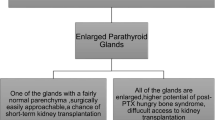Summary
During total parathyroidectomy and autotransplantation 140 enlarged glands were removed in 35 hemodialyzed patients (normocalcemic:n =14; hypercalcemic:n = 21). The crosssections of all glands were classified intraoperatively. Diffuse hyperplastic (type 1) and nodular hyperplastic (type 2) glands could be distinguished. Using a stereo-magnifier (magnification: × 10 − × 16), type 1a- (stromal fat cells!) and type lbglands (without stromal fat cells!) could be differentiated. Those areas were also found between the nodules of type 2-glands. Significantly, nodular hyperplastic glands predominated in hypercalcemic patients (χ 2-Test:p < 0.001). The colour of the nodules on the cross-sections of type 2-glands correlated with the predominating cell type (“dark”: nodule of oxyphile cells; “medium”: nodule of chief cells; “light”: nodule of ‘degenerating’ oxyphile cells). As sign of proliferation the mitotic index was elevated (>1:10000) in type 1b-glands, in type 1 b-like areas and in nodules of type 2-glands. These areas should not be used for autotransplantation.
Zusammenfassung
Im Rahmen der totalen Parathyreoidektomie und Autotransplantation wegen therapieresistentem renalen Hyperparathyreoidismus wurden bei 35 Hämodialysepatienten (normocalciämisch:n =14; hypercalciämisch:n = 21) insgesamt 140 vergrößerte Epithelkörperchen entfernt und am Querschnitt intraoperativ klassifiziert. Ohne Hilfsmittel war nur die Unterscheidung von diffusen (Typ 1) und nodulär hyperplastischen (Typ 2) Drüsen möglich. Innerhalb der Typ 1-Drüsen konnten unter Verwendung einer Stereolupe (10-und 16fache Vergrößerung) in Typ 1a- (Fettzellen!) und Typ 1b-Drüsen (Fehlen von Fettzellen!) differenziert werden. Ähnlich aufgebaute Areale fanden sich auch zwischen den Knoten der inhomogen aufgebauten Typ 2-Drüsen. Nodulär hyperplastische Drüsen kamen signifikant häufiger bei hypercalciamischen Patienten vor (χ 2-Test:p <0,001). Unterschiedliche Farbschattierungen am frischen Querschnitt der Typ 2-Drüsen erlaubten Rückschlüsse auf den cellulären Aufbau der durch Bindegewebssepten isolierten Knoten („dunkel”: oxyphile Zellknoten; „mittel”: Hauptzellknoten; „hell”: Knoten aus überwiegend degenerierenden` oxyphilen Zellen). Vor allem in Typ 1b-Düsen und Typ 1bähnlichen Arealen sowie in den isolierten Knoten der Typ 2-Drüsen fand sich ein erhöhter Mitoseindex (> 1:10 000) als Zeichen einer erhöhten Proliferation. Diese Areale sollten von einer Autotransplantation ausgeschlossen werden.
Similar content being viewed by others
Literatur
Adami S, Muirhead N, Manning RM, Gleed JH, Pappoulos SE, Sander LM, Catto GRD, O'Riordan JLH (1982) Control of secretion of parathyroid hormone in secondary hyperparathyroidism. Clin Endocrinol 16:463–473
Akerström G, Malmaeus J, Grimelius L, Ljunghall S, Bergström R (1984) Histological changes in parathyroid glands in subclinical and clinical renal disease — an autopsy investigation. Scand J Urol Nephrol 18:75–84
Banerjee SS, Faragher B, Halseton PS (1983) Nuclear diameter in parathyroid disease. J Clin Pathol 36:143–148
Diethelm AG, Adams PL, Murad TM, Daniel WW, Whelchel JD, Rutsky EA, Rostand SG (1981) Treatment of secondary hyperparathyroidism in patients with chronic renal failure by total parathyroidectomy and parathyroid autograft. Ann Surg 193:777–793
Hasleton PS, Ali HH (1980) The parathyroid in chronic renal failure — a light and electron microscopical study. J Pathol 132:307–323
Kay S (1976) The abnormal parathyroid. Hum Pathol 7: 127–138
Krause MW, Hedinger ChE (1985) Pathologic studies of parathyroid glands in tertiary hyperparathyroidism. Hum Pathol 16:772–784
Lawrence DAS (1978) A histological comparison of adenomatous and hyperplastic parathyroid glands. J Clin Pathol 31:626–632
Malmaeus J, Grimelius L, Johansson H, Akerström G, Ljunghall S (1984) Parathyroid pathology in hyperparathyroidism secondary to chronic renal failure. Scand J Urol Nephrol 18:157–180
Morrissey J, Martin K, Hruska K, Slatopolsky E (1984) Abnormalities in parathyroid hormone secretion in primary and secondary hyperparathyroidism. Adv Exp Med Biol 178:389–398
Niederle B, Roka R, Brennan MF (1982) The transplantation of parathyroid tissue in man: development, indications, technique and results. Endocrine Rev 3:245–279
Niederle B, Roka R, Hörandner H (1988) Rezidivierender Hyperparathyreoidismus: Reoperation am Autotransplantat. Wien Klin Wochenschr 100:369–372
Niederle B, Hörandner H, Roka R, Woloszczuk W, Waldhör Th (1988) Parathyreoidektomie und Autotransplantation beim renalen Hyperparathyreoidsmus: II. Funktionelle in vitro Untersuchungen zur Gewebeauswahl. Langenbecks Arch Chir 373:337–344
Niederle B, H6randner H, Roka R, Woloszczuk W (1989) Parathyreoidektomie und Autotransplantation beim renalen Hyperparathyreoidismus: Klinische und laborchemische Untersuchungen nach Gewebeauswahl. Chirurg 60 (im Druck)
Niederle B, Hörandner H, Roka R, Woloszcuzuk W (1988) Parathyreoidektomie und Autotransplantation beim renalen Hyperparathyreoidismus: Morphologische und funktionelle Untersuchungen bei transplantatsabhängigem Rezidiv. Chirurg 60 (im Druck)
Roth SI (1962) Pathology of the parathyroids in hyperparathyroidism. Arch Pathol Lab Med 73:75–90
Roth SI, Marshall RB (1969) Pathology and ultrastructure of the human parathyroid glands in chronic renal failure. Arch Intern Med 124:397–407
Rudberg C, Akerström G, Ljunghall S, Grimelius L, Johansson H, Pertoff H, Wide L (1982) Regulation of parathyroid hormone release in primary and secondary hyperpa rathyroidism — studies in vivo and in vitro. Acta Endocrinol (Kph) 101:408–413
Takagi H, Tominaga Y, Uchida K, Yamada N, Kano T, Kawahara K, Suzuki H (1983) Polymorphism of parathyroid glands in patients with chronic renal failure and secondary hyperparathyroidism. Endocrinol Jpn 30:463–468
hiele J, Ringe B, Jonas M, Hesch RD (1986) Hyperparathyreoidismus — ein Vergleich morphologischer Befunde an den Epithelkbrperchen mit klinischen Daten bei 195 Patienten. Pathologe 7:36–49
Author information
Authors and Affiliations
Rights and permissions
About this article
Cite this article
Niederle, B., Hörandner, H., Roka, R. et al. Parathyreoidektomie und Autotransplantation beim renalen Hyperparathyreoidismus. Langenbecks Arch Chiv 373, 325–336 (1988). https://doi.org/10.1007/BF01272551
Received:
Issue Date:
DOI: https://doi.org/10.1007/BF01272551




